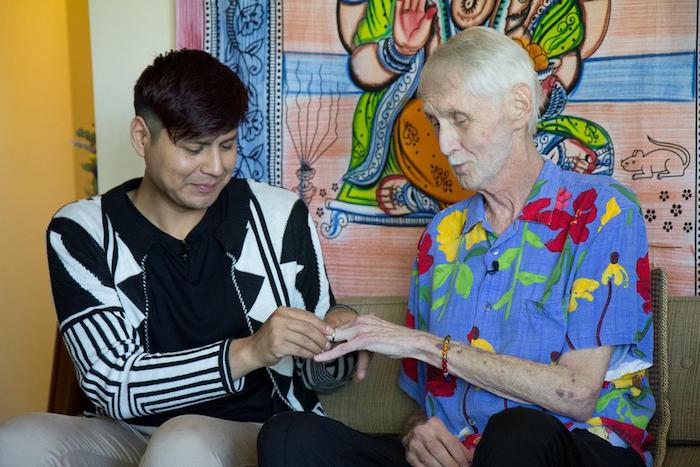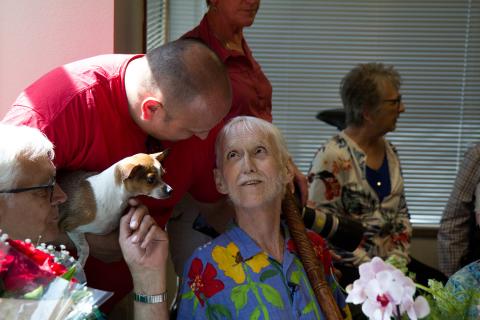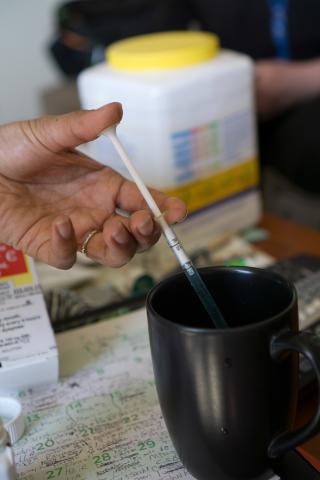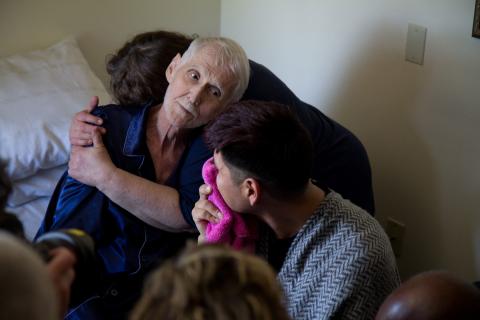Robert Fuller planned every detail of his wedding — and his death soon after

For the last hours of his 75 years on Earth, Robert Fuller was married to a man who he loved.
“I anoint you,” said Nancy Rebecca, a nurse, clairvoyant and sometime wedding officiant, “Mr. Robert and Mr. Reese Baxter-Fuller.”
The cameras flashed, the tape rolled as Fuller and Reese Baxter exchanged vows, rings and a chaste kiss. It was a simple wedding. The couple sat on the couch in their shared apartment in Primeau Place, a senior housing building on Capitol Hill. Baxter wore a black and white sweater, Fuller a relatively restrained Hawaiian shirt with large, colorful flowers against a cerulean background, ready for the party that waited for the newlyweds downstairs. The ceremony commenced at 10:30 a.m. By evening, Robert Fuller would be dead.
The cancer was slowly choking him
Robert Fuller planned every detail of his death. He knew who he wanted to see — invites had gone out weeks before — and what music he wanted to play him out. He’d also planned the food, although he himself couldn’t eat it.
Fuller was dying of a virulent strain of cancer, a disease that lodged itself in his throat and, over the course of a year, was slowly choking the life from him. At the end of March, he already had significant difficulty swallowing, leaving most of his meals to be transmitted through the gastric tube installed in his stomach, hidden by clothes that hung on his tall, wasted frame.
A nurse by training, Fuller knew what the future held if he decided to wage chemical war against his opponent.
“I’ve taken care of patients like me,” Fuller said, sitting in his recliner, staring out his window at a view of the sunlit Puget Sound. “I have a friend whose father died of the same thing 50 years ago. He did pursue all of it, all of the radiation. I only did a little bit of it. He did it all and it was a horrible death.”
That slow, painful, fruitless fight was not how Fuller wanted to spend his final days. He wanted to die as he lived — on his terms. He turned to Death with Dignity.

A public death
Death with Dignity began as an initiative passed by Washington voters in 2008. It allows terminal patients to end their lives by ingesting toxic amounts of drugs rather than suffer in their final months, weeks or days. They ease into sleep and never wake up.
Fuller became aware of it when a woman from California moved into the senior housing building in which he lived and helped manage.
“Wendy was her name,” Fuller recalled. “She started telling me about it pretty quickly, because that’s what people do when they meet me. Strangers tell me everything. On the bus, I don’t care where. They confess to me, they tell me their worst medical problems. They do. It just happens.”
Wendy moved to Washington to kill herself. It was one of the few states that allowed it. Although California would follow suit in 2016, Wendy didn’t have that long.
On the day she was to die, Wendy had a sign put on her door that read “Do Not Disturb.” When it came down, she was gone.
“I said, ‘Woah,’” Fuller said. “That solidified it for me. That’s what I’m going to do.
“But,” he continued, his voice hushed into a conspiratorial whisper, “mine is not going to be private. That is not the way I lived my life.”
Sharing stories, saying goodbye
Everybody seemed to call it something different. “Death Day.” “The Day.” Fuller didn’t care. When he spoke of it, he generally just referred to it as May 10.
“I’ll see you on May 10,” he told visitors in the days leading up to the event.
A gaggle of brightly colored helium balloons marked the entrance to Primeau Place’s common room, an open space lit harshly with fluorescent light. A piano stood against the eastern wall, a drumset assembled beside for the occasion.
People flooded the space, spilling out into the small patio that was sheltered from the spring sun by large trees. They munched on hors d’oeuvres, laughed and shared stories of Uncle Bob, as most people called him.
All the while, Fuller held court, seated next to his new husband as his guests came, one by one, to say their final goodbyes. He held a walking stick sanded down and polished into a smooth, golden surface and carved with tight grooves.
Someone he had sponsored made it for him while still using crack, Fuller had said more than a month before.
“I think that’s significant,” he said. “For people who are still into drugs and think nothing positive can still come out of this.”
That depth of compassion, of acceptance and understanding drew people to Fuller. He’d sponsored many in the room through the Alcoholics Anonymous program. He spent 10 years as a nurse in King County jail. He was an active member of St. Therese Catholic Church. He arranged for Primeau Place to “Adopt-A-Drain” outside the building to give back in another way.
Fuller was many things, said Scott Farrell, who had met Fuller at a spiritual retreat for gays and lesbians more than 40 years prior.
“He was always there for me,” Farrell said. “He was a light in my life. We haven’t been in touch a lot lately, but whenever I see him, it feels like there is no time.”
Nicholas Bross was one of the people Fuller sponsored. He was dressed in a Hawaiian shirt, a gift from Fuller specially for his big day.
“I’m supportive of his choice, his decision to do this,” Bross said. “I’ve been telling people that if I were in his shoes, I’d be doing the same thing.”
It took time for some to accept what he wanted to do, Fuller said. Most made their peace with it after the initial shock. Fuller gave them the space to process on their own terms. They might not be ready, but Fuller was. He had been for decades.

Escaping death during the AIDS epidemic
It was 1985. Fuller was living in Chelan, Washington, a handsome young man in his early 40s playing Schroeder, the philosophical musician, in a local production of “You’re A Good Man, Charlie Brown.”
He stopped paging through an old album and touched a photograph of his younger self with a frail finger. In the moment, a dapper Fuller was standing on stage with a seated woman playing a smitten Lucy.
“I have HIV in this picture, but I don’t know it,” Fuller said.
He had moved to Chelan to get away from the death he saw ravaging the gay community in Seattle. Fuller, a recovering alcoholic, watched as two or three young men a week disappeared from his Alcoholics Anonymous meetings.
“It just kept going, so I moved to Chelan,” he said. “There were no gay people and no AIDS, I told myself.”
He’d already taken the test by the time he appeared in that musical. The results would come back negative, but in his bones, he knew they were wrong.
That was when Fuller began packing his bags.
That was the phrase his community used to describe planning for their own deaths. Getting your living will in order, designating a power of attorney, making arrangements for your loved ones.
In the 1980s and 1990s, HIV could be a death sentence. Fuller stood by the sides of two men who he loved as they died. Chet, a swarthy man seated next to Fuller as the pair stare out over a lake, would be reduced to skin and bones in a matter of months. Bill, whom Fuller thought of as his first husband, although they could not legally wed, also died. Tom, an artist who Fuller described as a Jesus figure, appeared in a picture with Fuller at Chet’s funeral.
He would be dead a year later.
At the height of the epidemic, Fuller “packed his bags” every six months to a year. His viral load soared to 700,000 and his T-cell count dropped to 76, laying his body open to infection and possibly death. But he survived until the cocktail of drugs created in the late 1990s hit the market. He resisted the previous medications — those cures also killed.
Until his death, Fuller’s viral load was undetectable, but he carried the symptoms of HIV on his body. When he walked, he would pick up his feet like they were on marionette strings and plant them slowly and carefully on the carpet. It was called peripheral neuropathy, he said, lapsing into the assured cadences of a health care professional.
The loss of proprioception that comes with peripheral neuropathy brought Reese Baxter into his life. Baxter needed a place to stay, Fuller needed someone to help him — he’d fallen many times and struck his head.
“I didn’t know it would be three years,” Fuller said.
How to die with dignity
Dying seems easy. After all, we spend so much time and energy avoiding it.
Dying with dignity? That takes work.

First, you have to find a doctor willing to let you die. The law doesn’t mandate that doctors participate in Death with Dignity, it only says that they can. Many won’t, for personal reasons. Others can’t because they are forbidden to do so by their employers.
Hospitals that belong to the University of Washington medical network opt in, said Professor Helene Starks, an expert in medical ethics who has been studying end-of-life issues for three decades.
“I think that the general feeling is as a public institution enacting a public law, there was an obligation to provide access,” Starks said.
Swedish Medical Center, in contrast, is affiliated with Providence Health & Services, a Catholic nonprofit organization founded by the Sisters of Providence in 1856. The Swedish Medical Center in Seattle does not forbid its employees from engaging in Death with Dignity, according to a position statement issued after the law passed, although some Catholic-affiliated hospitals do.
This partly explains why as much as 90 percent of people in Washington who use the act do so west of the Cascades — access is extremely limited in the eastern portion of the state.
Fuller was able to receive care at Harborview Medical Center. First, he had to make an oral request. The doctor evaluated him to make sure that he was of sound mind — people with dementia cannot use Death with Dignity. It takes two doctors, one attending and one consulting, to complete the process.
No less than 15 days later, you have to make a second oral request. Fuller’s doctor accidentally scheduled his follow-up 14 days after the initial appointment. He had to come back the next day.
Once a person has jumped through these hoops and gets the prescription for the drug, they must find a pharmacy willing to fill it. This gets complicated, because pharmacists, like doctors, do not have to fill the script if they are opposed to the practice and some don’t have the expertise.
If you can find one — and there are a few in the area — the pharmacy has to be able to access the drugs.
Secobarbital — marketed under the name Seconal — is the preferred option. Called “reds” back in the day, secobarbital was used as a sleep aid until the danger of overdosing and negative interactions with alcohol became apparent.
Bausch Health, formerly Valeant Pharmaceuticals, bought the patent for the drug when it expired. Although the chemical makeup of the drug hasn’t changed in 80 years, the price did. When California passed its End of Life Option Act in 2015, the price of the drug doubled, according to NPR.
Today, the 100 capsules needed to end Fuller’s life would have cost him more than $3,000 without insurance.
Medical professionals created a cheaper cocktail of four drugs that cost roughly $400, but that is where the expertise comes in. A generic pharmacy can’t make the cocktail, but a compounding pharmacy can.
In the end, Fuller would use the cocktail — his pharmacy was not able to get the necessary amount of secobarbital.
The whole process takes weeks if not months for people who, by law, must have a six-month prognosis.
“You have to adhere to a strict process,” Fuller said. “You don’t just walk in and say, ‘I want to get rid of Grandma. I hear you have death panels.’”
Final act
As the clock ticked closer to 3 p.m., the mood at the party changed.
The jovial atmosphere gave way to the weight of the moment as the minute hand ticked by, moving inexorably closer to the time of Fuller’s death.

He went upstairs, his husband on one side, his walking stick on the other. There were balloons outside his apartment door as well, framing a nametag attached to the name plate that read “Uncle Bob.”
Bodies pressed into the small apartment, filling the T-shaped corridor that led from the front door to Fuller’s room on the left and the living room on the right. Fuller went into his room with a select few — he changed into a ocean-blue set of shiny pajamas, the “Hugh Hefner” pajamas, as he liked to call them.
He lay there, his twin bed strewn with pink rose petals, Baxter at his side, holding his hand.
In March, Fuller said that Baxter would hold his hand in a “fishhook,” a wrestling grip that is next to impossible to break until one of the parties lets go.
“He’s now the person whose hand I want to be holding when I die,” Fuller said. “He’s going to give me the cue when I’m falling asleep, or when I seem to be sleeping, that I can leave.”
When the doors opened, Fuller’s friends, adopted family and loved ones shuffled into the room until there was no space left. People squeezed into every nook and cranny, shoved into a closet, trying to use a flimsy clothing basket for support.
By law, Fuller had to ingest the drugs on his own. Many choke it down — the taste is terrible, bitter. He took a syringe and injected the poisonous cocktail into his gastric tube.
Almost a third of people who get the prescriptions never take it. Not Fuller. Now, he would die.
Baxter gripped Fuller’s hand, the other holding an electric pink towel he used to absorb his tears. A violinist put bow to strings, playing Amazing Grace and Ave Maria. As Fuller’s eyes closed and his body went still, the observers raised their voices in song. Those closest to him placed their hands on his body in farewell.

Technically, he was asleep. Death would come later, after the drugs wrested his final breath away from the cancer that tried to steal it. But Bob Fuller was gone.
Complete Article ↪HERE↩!
